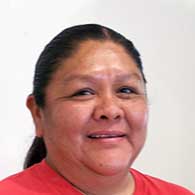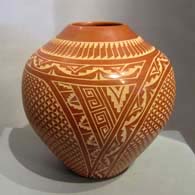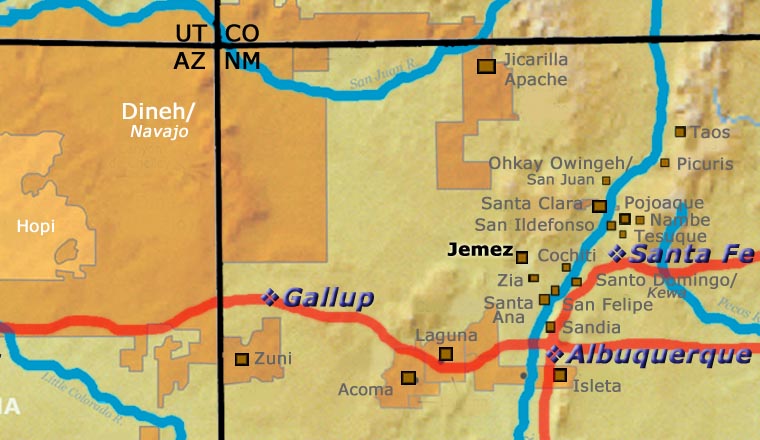
Wilma Baca Tosa
Jemez

Wilma Baca, (New Wheat), was born to John and Linda Baca of Jemez Pueblo in September 1967. She was inspired to make pottery by her grandmother, Marie Reyes Shendo. Marie taught Wilma the fundamentals of making pottery the traditional way using ancient methods passed down from their ancestors.
Wilma specializes in hand coiled, stone polished and traditionally decorated Jemez pottery. She makes redware bowls, jars, seed pots, vases and wedding vases. She has been etching her pottery using the free-hand sgraffito technique since 1989. Her favorite piece to make is the wedding vase because of its meaning: "The spouts represent two separate lives, the bridge across the middle unites these separate lives as one," she says.
100 West San Francisco Street, Santa Fe, New Mexico 87501
(505) 986-1234 - www.andreafisherpottery.com - All Rights Reserved

Jemez Pueblo

Ruins of San Jose de las Jemez Mission
As the drought in the Four Corners region deepened in the late 1200's, several clans of Towa-speaking people migrated southeastward to the Canyon de San Diego area in the southern Jemez mountains. Other clans of Towa-speaking people migrated southwest and settled in the Jeddito Wash area in northeastern Arizona, below Antelope Mesa and southeast of Hopi First Mesa. The migrations began around 1275 and were mostly complete by 1350.
Archaeologist Jesse Walter Fewkes argues that pot shards found in the vicinity of the ruin at Sikyátki (near the foot of Hopi First Mesa) speak to the strong influence of earlier Towa-speaking potters on what became "Sikyátki Polychrome" pottery (Sikyátki was a village at the foot of First Mesa, destroyed before the first Hopi contact with the Spanish in 1540). Fewkes maintained that Sikyátki Polychrome pottery is the finest ceramic ware ever made in prehistoric North America.
Francisco de Coronado and his men arrived in the Jemez Mountains of Nuevo Mexico in 1539. By then the Jemez people had built several large masonry villages among the canyons and on some high ridges in the area. Their population was estimated at about 30,000 and they were among the largest and most powerful tribes in Northern New Mexico. Some of their pueblos reached five stories high and contained as many as 3,000 rooms.
Because of the nature of the landscape they inhabited, farming was very hard. So the Jemez became traders, too, and their people traded goods all over the Southwest and northern Mexico.
The arrival of the Spanish was disastrous for the Jemez and they resisted the Spanish with all their might. That led to many atrocities against the tribe until they rose up in the Pueblo Revolt of 1680 and evicted the Spanish from northern New Mexico. With the Spanish gone, the Jemez destroyed much of what they had built on Jemez land. Then they concentrated on preparing themselves for the eventual return of the hated priests and the Spanish military.
The Spanish returned in 1692 and their efforts to retake northern New Mexico bogged down as the Jemez fought them doggedly for four years. In 1696 many Jemez came together, killed a Franciscan missionary and then fled to join their distant relatives in the Jeddito Wash area. They remained at Jeddito Wash for several years before returning to the Jemez Mountains. As a result of that long ago contact, there are still strong ties between the Jemez and their cousins on Navajo territory at Jeddito. On their return to the Jemez Mountains, the people built the pueblo they now live in (Walatowa: The Place) and made peace with the Spanish government.
Some of the Jemez people had been making a type of plainware pottery (simple, undecorated, utilitarian) when they were still in the Four Corners area, while others had developed a distinctive type of black-on-white pottery. In moving to the Jemez Mountains, they brought their knowledge and techniques with them but had to adapt to the different materials available to work with. Over time, the Jemez got better in their agricultural practices and began trading agricultural goods to the people of Zia Pueblo in return for pottery. By the mid-1700's, the Jemez were producing almost no pottery.
East of what is now Santa Fe is where the ruins of Pecos Pueblo are found. Pecos Pueblo was a large pueblo housing up to 2,000 people at its height. The people of Pecos and the Galisteo Basin were the only other speakers of the Towa language in New Mexico and when that area fell on increasingly hard times (Apache and Comanche raids, European diseases, drought), Pecos was finally abandoned in 1838 when the last 17 residents moved to Jemez. The Governor of Jemez welcomed them and allowed them to retain many of their Pecos tribal offices (governorship and all). Members of former Pecos families still return to the site of Pecos Pueblo every year to perform religious ceremonies in honor of their ancestors.
When general American interest in Puebloan pottery started to take off in the 1960's, the people of Jemez sought to recover that lost heritage. Today, the practice of traditional pottery-making is very much alive and well among the Jemez.
The focus of Jemez pottery today has turned to the making of storytellers, an art form that now accounts for more than half of their pottery production. Storytellers are usually grandparent figures with the figures of children attached to their bodies. The grandparents are pictured orally passing tribal songs and histories to their descendants. While this visual representation was first created at Cochiti Pueblo (a site in close geographical proximity to Jemez Pueblo) in the early 1960's by Helen Cordero, it speaks to the relationship between grandparents and grandchildren of every culture.
The pottery vessels made at Jemez Pueblo today are no longer black-on-white. Instead, the potters have adopted many colors, styles and techniques from other pueblos to the point where Jemez potters no longer have one distinct style of their own beyond that which stems naturally from the materials they themselves acquire from their surroundings: it doesn't matter what the shape or design is, the clay says uniquely "Jemez."
100 West San Francisco Street, Santa Fe, New Mexico 87501
(505) 986-1234 - www.andreafisherpottery.com - All Rights Reserved

Nampeyo of Hano Family Tree
Disclaimer: This "family tree" is a best effort on our part to determine who the potters are in this family and arrange them in a generational order. The general information available is questionable so we have tried to show each of these diagrams to living members of each family to get their input and approval, too. This diagram is subject to change should we get better info.
-
Nampeyo of Hano (c. 1859-1942) & Lesou (c. 1860-1942)
- Annie Healing Nampeyo (1884-1968) & Will Healing
- Rachel Namingha Nampeyo (1903-1985) & Emerson Namingha (d. 1992)
- Priscilla Namingha Nampeyo (1924-2008) & Donnelly Sahmie (d. 2008)
- Jean Sahmie (1949- ) & Gordon Tom
- Donella Tom Zacharias (1972- )
- Kaniela Kootswatewa
- Donella Tom Zacharias (1972- )
- Randall Sahmie Nahto (1950-2008) & Alicia (1950- )
- Randall Sahmie Jr. & Lisa Willa
- Andrew Louis Sahmie (1952- ) & Ida Sahmie (Dineh)(1960- )
- Nyla Sahmie (1954- ) & Philip Collateta
- Kenneth Lynch (1974- )
- Tara Lynch
- Kira Lynch
- Michael Collateta (1981- )
- Christopher Collateta
- Seth Collateta
- Kenneth Lynch (1974- )
- Rachel Sahmie (1956-2022) & Ollie Talashie
- Carla Talashie
- Sean Michael Talashie
- Madison Moreno
- Carla Talashie
- Bonnie Chapella Sahmie Nampeyo (1958- ) & Ernest Chapella
- Doyle Sahmie
- Mickie Chapella
- Sahmie Chapella
- Jean Sahmie (1949- ) & Gordon Tom
- Ruth James Namingha (1926-2012)
- Darlene Vigil James (Nampeyo) (1956- ) & Felix Vigil (Jemez)
- Candice James
- Darlene Vigil James (Nampeyo) (1956- ) & Felix Vigil (Jemez)
- Eleanor Lucas (1926- )
- Karen Lucas
- Steve Lucas (1955- ) & Yvonne Analla Lucas (Laguna/Navajo, 1959- )
- Emerson Namingha
- Les Namingha (1967- ) & Jocelyn Quam Namingha (Zuni)
- Lillian Namingha
- Dextra Quotskuyva Nampeyo (1928-2019)
- Hisi Quotskuyva Nampeyo (1964- )
- Lowell Chereposy
- Erica Quotskuyva
- Reid Ami
- Hisi Quotskuyva Nampeyo (1964- )
- Priscilla Namingha Nampeyo (1924-2008) & Donnelly Sahmie (d. 2008)
- Daisy Hooee Nampeyo (1906-1994)
- Louella Naha (1927- ) & Fred Enote Jr.
- Raymond Naha (1929-1975)
- Shirley Benn (1936- )
- Cheryl Naha (1961- )
- Marlin Pinto (1957- )
- Beatrice Naha Nampeyo (1912-1942) & Vinton Naha
- Regina Naha
- Terry Naha
- Regina Naha
- Dewey Healing (1905-1992) & Juanita Healing (1910-2006)
- Rachel Namingha Nampeyo (1903-1985) & Emerson Namingha (d. 1992)
- Nellie Nampeyo Douma (1896-1978) & Douglas Douma
- Marie Koopee (1917- )
- Jacob Koopee, Sr. (1940- ) & Georgia Dewakuku Koopee (1944- )
- Jacob Koopee Jr. (1970-2011)
- Jacob Koopee, Sr. (1940- ) & Georgia Dewakuku Koopee (1944- )
- Augusta Poocha Nampeyo (d. pre-1998)
- Zella Douma Ray [Kooyquaptewa][Nez]
- Marie Koopee (1917- )
- Fannie Polacca Nampeyo (1900-1987) & Vinton Polacca
- Elva Tewaguna Nampeyo (1926-1985)
- Miriam Tewaguna Nampeyo (1956- )
- Adelle Lalo Nampeyo (1959- ) & David Lalo
- Elton Tewaguna (1953- )
- Neva Polacca Choyou Nampeyo (1947- )
- Leah Garcia Nampeyo (1928-1974) & Lewis Garcia (1928-1974)(Laguna)
- Melda Nampeyo (1959- )
- Eloy Navasie
- James Garcia Nampeyo (1958-2019) & Fawn Navasie
- Rayvin Garcia Nampeyo (1961- ) & Jody (1/2 Zia)
- Melda Nampeyo (1959- )
- Harold Polacca Nampeyo (1930- ) & Alice Polacca
- Clinton Polacca (1958-2022)
- Vernida Polacca Nampeyo (1955- )
- Jeremy Adams (1988- ) & Mallorie Ovah
- Wiley Adams
- Jeremy Adams (1988- ) & Mallorie Ovah
- Reva Polacca Ami (1964- )
- Tonita Hamilton Nampeyo (1934- ) & Eugene Hamilton
- Loren Hamilton (1961- )
- Tom Polacca (1935-2003)
- Gary Polacca Nampeyo (1955- )
- Delmar Polacca
- Carla Claw Nampeyo (1961- )
- Elvira Naha (1968- ) & Marty Naha (1970- )
- Ellsworth Polacca Nampeyo (1940-1993)
- Iris Youvella Nampeyo (1944- ) & Wallace Youvella, Sr. (1947-2021)
- Doran Youvella (1982- )
- Nolan Youvella (1970-2020)
- Wallace Youvella Jr.
- Elva Tewaguna Nampeyo (1926-1985)
- William Lesou Komalestewa (1893-1935) & Vina Tahomana (d. 1918)
- Austin Komalestewa Sr. (1916-1987) & Emily Shupla (Hopi)
- Alton Komalestewa & Jeanne Shupla (Santa Clara) (d. 1989)
- Austin Komalestewa Sr. (1916-1987) & Emily Shupla (Hopi)
Some of the above info is drawn from Hopi-Tewa Pottery: 500 Artist Biographies, by Gregory Schaaf, © 1998, Center for Indigenous Arts & Studies. Other info is derived from personal contacts with family members plus interminable searches of the Internet and cross-examinations of the data found.
(505) 986-1234 - www.andreafisherpottery.com - All Rights Reserved
